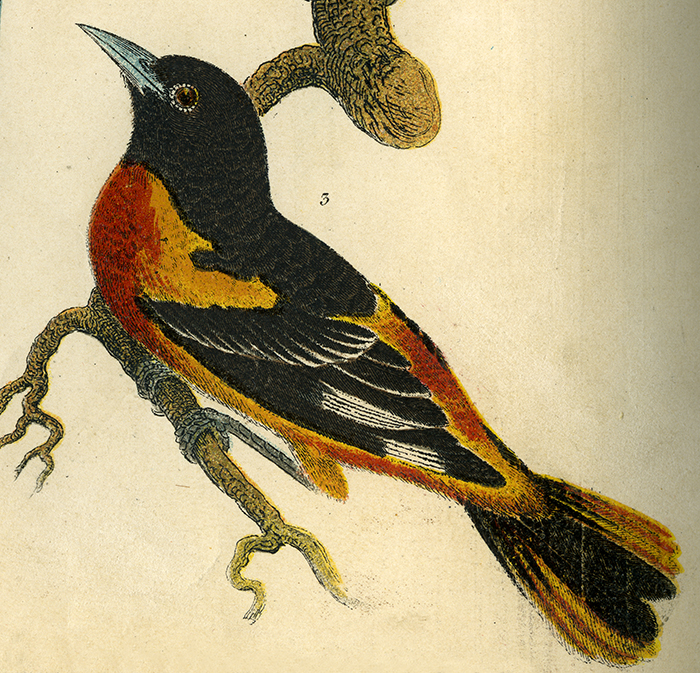
Linn. Syst. i. p. 162, 10.
Icterus minor, Briss, ii. p. 109, 19. t. 12. fig. 1.
Le Baltimore Buff. iii. p. 231. Pl. enl. 506. fig. 1.
Baltimore Bird, Catesb. Carr. i. 48.
Arct. Zool. p. 142.
Lath. Syn. ii. p. 432, 19.
Bartram, p. 290.
Peale's Museum, No. 1506.
ICTERUS BALTIMORE.—DAUDIN.
Yphantes Baltimore, Vieill. Gal. des Ois. pl. 87.
Icterus Baltimore, Bonap. Syn. p. 51.
North. Zool. ii. p. 284.
Baltimore Oriole, pl. 12 and Orn Biog. p. 66.
This is a bird of passage, arriving in Pennsylvania, from the south, about the beginning of May, and departing toward, the latter end of August, or beginning of September.[13] From the singularity of its colours, the construction of its nest, and its preferring the apple trees, weeping willows, walnut and tulip trees, adjoining the farmhouse, to build on, it is generally known, and, as usual, honoured with a variety of names, such as hang-nest, hanging bird, golden robin, fire bird (from the bright orange seen through the green leaves, resembling a flash of fire), &c., but more generally the Baltimore bird, so named, as Catesby informs us, from its colours, which are black and orange, being those of the arms or livery of Lord Baltimore, formerly proprietary of Maryland.
The baltimore oriole is seven inches in length; straight, strong, tapering to a sharp point, black, and sometimes lead coloured, above, the lower mandible light blue towards the base. Head, throat, upper part of the back and wings, black; lower part of the back, rump, and whole under parts, a bright orange, deepening into vermilion on the breast; the black on the shoulders is also divided by a band of orange; exterior edges of the greater wing-coverts, as well as the edges of the secondaries, and part of those of the primaries, white; the tail-feathers under the coverts, orange; the two middle ones, from thence to the tips, are black; the next five, on each side, black near the coverts, and orange towards the extremities, so disposed that, when the tail is expanded, and the coverts removed, the black appears in the form of a pyramid, supported on an arch of orange. Tail, slightly forked, the exterior feather on each side, a quarter of an inch shorter than the others; legs and feet, light blue, or lead colour; iris of the eye, hazel.
The female has the head, throat, upper part of the neck and back, of a dull black, each feather being skirted with olive yellow; lower part of the back, rump, upper tail-coverts, and whole lower parts, orange yellow, but much duller than that of the male; the whole wing- feathers are of a deep dirty brown, except the quills, which are exteriorly edged, and the greater wing-coverts, and next superior row, which are broadly tipt with a dull yellowish white; tail, olive yellow; in some specimens, the two middle feathers have been found partly-black, in others wholly so; the black on the throat does not descend so far as in the male, is of a lighter tinge, and more irregular; bill, legs, and claws, light blue.[14]
Buffon and Latham have both described the male of the bastard baltimore (Oriolus spurius) as the female baltimore. Mr Pennant has committed the same mistake; and all the ornithologists of Europe, with whose works I am acquainted, who have undertaken to figure and describe these birds, have mistaken the proper males and females, and confounded the two species together in a very confused and extraordinary manner, for which, indeed, we ought to pardon them, on account of their distance from the native residence of these birds, and the strange alterations of colour which the latter are subject to.
[13] During migration, the flight of the baltimore is high above all the trees, and is straight and continuous; it is mostly performed during the day, as I have usually observed them alighting, always singly, about the setting of the sun, uttering a note or two, and darting into the lower branches to feed, and afterwards to rest.—Audubon.—Ed. [return]
[14] The change of the plumage of this bird, according to age, is beautifully represented on one of Mr Audubon’s gigantic plates, together with its favourite tulip tree, and curious pensile nest. According to that gentleman, the male does not receive his full plumage until the third spring. In the male of one year, the bill is dark brown above pale blue beneath; the iris, brown; feet, light blue. The general colour is dull brownish yellow, tinged with olive on the head and back; the wings, blackish brown; the quills and large coverts margined and tipped with white; the lesser coverts are olivaceous; the tail, destitute of black; and the under parts paler than in the adult, without any approach to the vivid orange tints displayed on it. In that of the second spring, the distribution of colour has become the same as in the adult male, but the yellow is less vivid; the upper mandible is brownish black above, and the iris is light brown: in the third spring, they receive the rich and. brilliant plumage described by our auth or.—Ed. [return]

